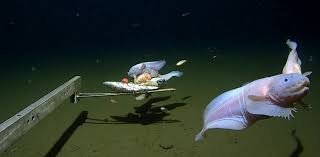The deep ocean is one of the most mysterious places on Earth. It is darker than midnight, colder than ice, and filled with intense pressure. Yet, thousands of unusual creatures live there. These deep-sea animals have strange shapes, glowing bodies, and surprising abilities that scientists are still trying to understand. In this article, we explore the science behind the mysterious life hidden in the ocean’s darkest depths.
The Deep Sea: A World Without Light
Sunlight cannot reach below 1,000 meters.
The deep ocean is completely dark, and creatures must adapt to survive without light.
Here, the environment includes:
• Freezing temperatures
• Crushing pressure
• Very little food
• Total darkness
Despite these harsh conditions, life has not only survived—it has evolved in amazing ways.
Bioluminescence: Animals That Glow
One of the strangest features of deep-sea creatures is bioluminescence—the ability to produce light.
This glowing effect is created through a chemical reaction inside their bodies.
Creatures use bioluminescence to:
• Attract prey
• Scare predators
• Communicate
• Camouflage
• Find mates
Famous glowing creatures include:
• Anglerfish
• Lanternfish
• Firefly squid
Extreme Pressure Adaptation
Pressure in the deep sea is so strong it can crush a submarine.
But deep-sea animals survive because their bodies are soft and flexible.
Key adaptations include:
• Gel-like skin
• No air-filled organs
• Flexible bones
• Special proteins that protect cells
These features prevent their bodies from breaking under extreme pressure.
Strange and Mysterious Creatures
1. Anglerfish
Known for its glowing lure on its head, the anglerfish uses light to attract prey in the darkness.
2. Giant Squid
Once thought to be a myth, the giant squid can grow up to 40 feet long.
Its massive eyes help it see in near darkness.
3. Blobfish
Often called the “ugliest fish,” the blobfish looks normal underwater.
Its body collapses only when brought to the surface because the pressure changes.
4. Gulper Eel
With a huge mouth that can expand like a balloon, it swallows prey much larger than itself.
5. Deep-Sea Jellyfish
Some jellyfish can glow in rainbow colors, create light patterns, and even release glowing liquid.
Scarce Food and Unique Diets
Food is limited in the deep ocean, so creatures have unusual eating habits.
Some methods include:
• Eating anything they find
• Slow metabolism to save energy
• Swallowing prey whole
• Feeding on “marine snow” (dead organisms that fall from above)
These strategies help them survive in a world where every meal is rare.
Survival Without Sunlight
Since sunlight never reaches the deep sea, plants cannot grow there.
Instead, some life forms rely on chemosynthesis—a process where bacteria create energy using chemicals from underwater volcanic vents.
These vents, called hydrothermal vents, release:
• Sulfur
• Hot water
• Minerals
Entire ecosystems live around these vents, proving life can exist without sunlight.
Why the Deep Sea Remains a Mystery
More than 80% of the ocean is still unexplored.
Scientists believe thousands of unknown species may still be hiding in the deep sea.
Challenges include:
• Extreme pressure
• Limited technology
• Vast distances
• Difficult exploration conditions
Every new discovery brings more questions about how life survives in such harsh environments.
Final Thoughts
The deep sea is one of Earth’s most mysterious and fascinating places. Its strange creatures and unique ecosystems show how life can adapt to even the toughest conditions. As technology improves, scientists hope to uncover more secrets hidden in the darkness of the ocean.
